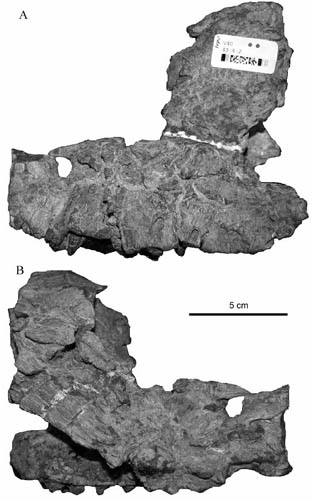New Study Turns Pachysuchus a Hidden Dinosaur - Removing Only Post-Triassic Record of Phytosaurs from Asia
Phytosaurs are generally considered to have become extinct at the end of the Triassic Period, but several records have suggested that they survived into the basal Jurassic in Europe and Asia. The Asian record consists of Pachysuchus imperfectus from the Lower Lufeng Formation (?Hettangian–Sinemurian) of Yunnan, China. Dr. Paul M. Barrett, Natural History Museum London, and Dr. XU Xing, Institute of Vertebrate Paleontology and Paleoanthropology (IVPP), Chinese Academy of Sciences, re-examined this specimen and found it differs from phytosaurs in numerous respects and is more likely a poorly preserved, indeterminate sauropodomorph dinosaur skull, thereby removing the post-Triassic record of phytosaurs from Asia. Researchers reported in the latest issue of Vertebrata PalAsiatica 2012(2).
The Lower Lufeng Formation of Yunnan has produced a globally important fauna of Early Jurassic reptiles and synapsids, including numerous sauropodomorph dinosaurs, tritylodontids and protosuchian crocodylomorphs. One of the more obscure taxa from this assemblage is the supposed phytosaur Pachysuchus imperfectus, which was described by C C Young (1951) on the basis of a single badly damaged partial snout. Although fragmentary, this specimen is potentially of wider significance as, if correctly identified as a phytosaur, this would represent the youngest-known occurrence of this clade, which is otherwise known primarily from the Late Triassic.
The specimen (Institute of Vertebrate Paleontology and Paleoanthropology [IVPP] V 40), collected from the Dark Red Beds northeast of Lufeng, was initially referred to the sauropodomorph dinosaur ‘Lufengosaurus magnus’, but was later redescribed and identified as a phytosaur. Although Pachysuchus imperfectus has been mentioned in the literature on numerous occasions, often in the context of either palaeobiogeographical distributions or Triassic/Jurassic (Tr/J) faunal turnover, it has never been redescribed.
“It was thought that the holotype specimen had been lost. A recent search of the IVPP collections relocated the holotype, allowing it to be re-described and compared with other Lower Lufeng taxa and phytosaurs. We re-examined the holotype of P. imperfectus but we noted it is not a phytosaur. The damaged skull piece exhibits many traits never seen in phytosaurs but that closely match what paleontologists have documented among sauropodomorph dinosaurs. Exactly what species of dinosaur the jaw belonged to is impossible to say—the appropriate traits for a species identification may be missing—but the best fit is certain some variety of sauropodomorph”, said co-author Dr. XU Xing.
“Establishing the presence or absence of this clade in the Jurassic is of some significance as it is generally believed that all phytosaurs became extinct at, or just prior to, the Tr/J boundary. Therefore, the confirmed presence of phytosaurs in post-Triassic deposits would potentially alter the known pattern of extinction dynamics across this important interval”, said lead author Dr. Paul M. Barrett, “Phytosaur records from the earliest Jurassic of Europe are either ambiguous or erroneous and there is no convincing evidence to support the survival of the clade beyond the Triassic, suggesting that phytosaur remains might have biostratigraphical utility for dating Late Triassic deposits”.
This work was supported by the Palaeontological Innovation Fund of the Natural History Museum, London and the National Science Foundation of China. 
Fig.1 Holotype specimen of ‘Pachysuchus imperfectus’ (IVPP V 40). A, left lateral view; B, right lateral view (Image by XU Xing) 
Fig.2 Outline drawing of the skull of the basal sauropodomorph dinosaur Massospondylus carinatus from the Lower Jurassic of southern Africa. Shaded area represents the anatomical region represented by the skull fragment of Pachysuchus imperfectus.( Image by R. Laws)
Download attachments: